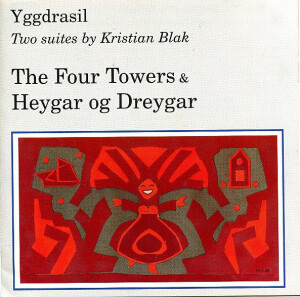I must confess that before I heard this disc, I had no idea what I was in for. Coming from a purely classical background, I have had a fascination with jazz but little real knowledge to support it. Thus I was immensely curious as to what a crossover of the two mediums would entail, and Kristian Blak, who has written music for both classical and jazz ensembles, seemed like the perfect introduction for me.
And it was, although not in the way I was expecting. I had some preconceived notion of what “classical jazz” meant – perhaps a kind of tame compromise involving the common elements of tonal and jazz idioms – but Kristian Blak’s work here exceeds those dimensions. His music is a stylistic cornucopia of contrasting sounds and styles, and I was genuinely surprised at how avant-garde his sensibilities were (though, in retrospect, this makes sense, considering the climate of classical music in the latter half of the 20th century). There are many purely jazz cues, of course, and these tend to lie within a more traditional scope of harmony and rhythm. But the overwhelming impression I got was one of an audaciously experimental musician who is not afraid to test new waters in order to further his artistic expression. This CD was thus a refreshing listen for me, although it will no doubt be challenging (even daunting) for many.
The first suite on the CD, entitled “The Four Towers,” is based on a folk poem by William Heinesen that details, in a mystical fashion, the characteristics of four towers (west, east, south, north). There are four sections of music corresponding each tower, and each is comprised of three movements. The sections seem to follow a characteristic pattern – each begins with an extremely free, naturalistic soundscape (usually incorporating and manipulating live recorded sounds from nature) and ends with a more traditional jazz movement, but beyond that the styles are all over the map. For instance, the section titled “Vojavoja” (the Tower in the East) begins with a loose texture that is completely non-tonal and arhythmic (i.e. you can’t tap to it) and incorporates wolf howls. This segues into “Teeth,” in which the instruments honk and bark out seemingly random and indefinite pitches, to incredible chaotic effect. “Vojavoja,” by comparison, is almost startlingly consonant.
“Amen-Amen” (The Tower in the South) is particularly notable for the way it is able to unify stylistically diverse elements. The section begins with “Faces,” which starts off as an impressive choral fugue suggesting a kind a kind of nostalgia for the Renaissance. “Clouds,” meanwhile, features the ultimate lazy, laid-back sax solo. These disparate soundscapes are integrated in a surprisingly effective fashion in the final movement, “Mouths.” The entire section, despite its contrasting features, has the same tranquil mood throughout.
The second suite on the CD, “Heygar og Dreygar” (Howes and Trowes), was inspired by Faroese folklore. Again, Blak takes advantage of the large variety of folklore characters at his disposal to fashion a suite of refreshingly diverse elements. “Dvørgamál” (dwarves’ language) opens with a stately militaristic drum tattoo and some distinctly french-horn-sounding flute riffs, which are then accompanied by an awkward piano/bass accompaniment, giving the impression of a bumbling creature pretending to be majestic. “Marmennil” refers to a tiny creature that teases fishermen by foiling their sport in various ways: the brilliantly whimsical duet between a nimble, agile flute and a clumsy-sounding sax thus makes perfect sense in context. The final track of the CD, “Flotoyggjar” (floating islands), is a great finale piece. Relaxed, slightly melancholy, and based on an ascending chord progression that repeats throughout, it has the character of a climactic ballad. It is also the most traditional in terms of harmony, rhythm and the obligatory improvisations (which range from impressive to eyebrow-raising – in a good way).
The performances by Yggdrasil, Blak’s jazz ensemble, are excellent throughout. Besides the aforementioned final track, there are notable solos throughout the album, particularly during “Rok,” the North Tower section of “The Four Towers.” The improvisations are thoroughly realized, and convey the impression of great freedom and enjoyment, though they may be a tad too frenetic for some listeners.
In the end, this is a CD that really opened my ears. I found Kristian Blak’s willingness to stretch the traditions of both jazz and classical music, to expand our preconceived notions of harmony, rhythm, timbre, and style for maximum expressive effect, to be refreshing and interesting. I respect an artist like Kristian Blak for respecting traditions while at the same time recognizing the untapped potential in the world of sound. But then, I am the type of listener who enjoys traditional music but also likes to feast on new sounds. This is thus a CD I would recommend for anyone who is up for an auditory adventure, one that is ultimately pleasant and rewarding even as it charts potentially uncomfortable musical waters.
(TUTL, 1983 and 1985; CD release 1998)

